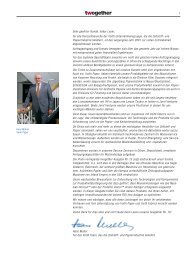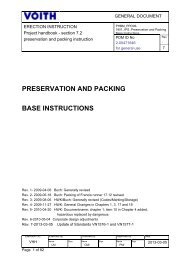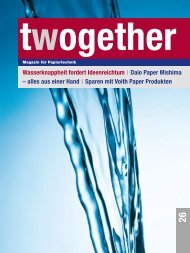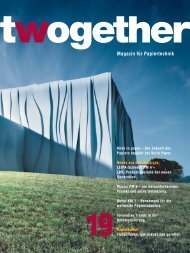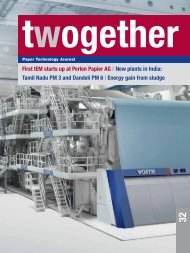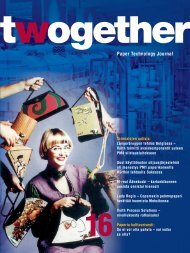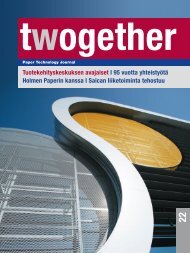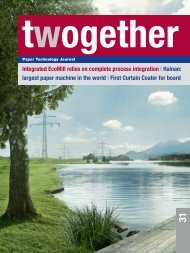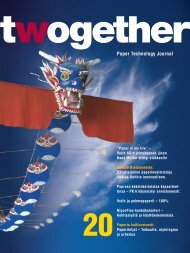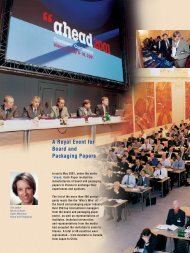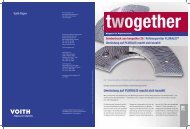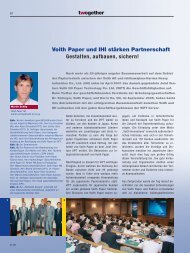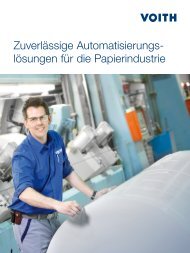Paper Technology Journal 19 - Voith
Paper Technology Journal 19 - Voith
Paper Technology Journal 19 - Voith
Create successful ePaper yourself
Turn your PDF publications into a flip-book with our unique Google optimized e-Paper software.
62<br />
Fig. 3: Schematic of air flow of the CB2 nozzles.<br />
Fig. 4: Web run concepts for drying the bottom<br />
side of the web.<br />
Left without HCB-Turn<br />
– long web run<br />
– motor driven rolls<br />
– risk of contamination.<br />
Right with HCB-Turn<br />
– short web run and simplified tail threading<br />
– fewer rolls<br />
– low risk of contamination.<br />
thermal stability of all CB-Dryers used is<br />
guaranteed.<br />
Another feature of the CB2 nozzle is the<br />
special geometry of the air nozzle. The<br />
nozzle outlet openings, placed opposite<br />
to each other, generate an extremely<br />
stable cushion pressure and, due to the<br />
recessed arrangement of the holes, contamination<br />
is nearly impossible. As a result,<br />
downtime is greatly reduced (Fig. 3).<br />
In the CB-Dryer, the largest portion of the<br />
drying air is recirculated, whereby the<br />
drying air repeatedly makes contact with<br />
the web. This results in the transfer of<br />
more energy (energy efficiency). A certain<br />
portion of the air must, however, be<br />
continuously withdrawn from circulation<br />
in order to remove the steam that is<br />
being created. In the combination of<br />
CB-Dryers and infrared systems, the energy<br />
balance of the entire system can be<br />
optimized through the partial recovery of<br />
<strong>19</strong>/05<br />
the energy that is present in the combustion<br />
exhaust gases of the gas-fired IR<br />
emitters.<br />
The Krieger HCB-Turn for<br />
simultaneous turning<br />
and drying of a paper web<br />
3 4<br />
The Krieger HCB-Turn has been developed<br />
in response to persistent market demand<br />
concerning space requirements and<br />
web run, – both in the case of rebuilds<br />
and new installations, and recently went<br />
into operation.<br />
The construction of the HCB-Turn is<br />
based on our experience with the abovementioned<br />
excellent characteristics of the<br />
CB2 nozzle – which, for many years, has<br />
been used successfully in the Krieger CB-<br />
Dryer – and the optimized load-carrying<br />
capacity of the Krieger CB-Turn. Our<br />
challenge was to combine the high load-<br />
carrying capacity (turning of a paper or<br />
board web by 180° with high web draws)<br />
and high drying rates with simultaneous<br />
space-saving web guidance (Fig. 4).<br />
In extensive trials, the ratio of the width<br />
of the supply-air nozzle beam to the<br />
width of the exhaust gap in particular,<br />
was optimized and a patent is pending for<br />
this design. This feature ensures a high<br />
exhaust capacity even at high web draws,<br />
as is frequently the case in board production.<br />
It also results in uniform drying<br />
across the entire web width (Figs. 5-7).<br />
In non-contact web-turning systems, a<br />
certain amount of the air invariably escapes<br />
from the area of the cushion pressure<br />
into the atmosphere. In order to<br />
achieve the required high drying output,<br />
the air has to have a high temperature.<br />
Krieger has developed a suction system<br />
that recaptures a portion of this heated<br />
air on both drive and tending sides and



